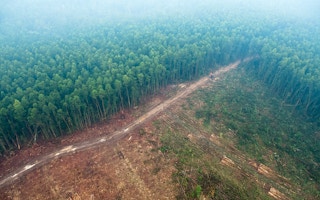Forest fires have intensified in Sumatra, raising questions about the government’s claims it has succeeded in tackling the annual problem.
An area spanning nearly 26 square kilometres (10 square miles), or about 5,000 football fields, has gone up in smoke in the province of Riau, according to local media reports. Eleven of the 12 districts that make up the province have been affected, with thousands of people suffering from breathing problems due to the haze from the fires.
“The fires in Riau these past two months have been severe,” Muhammad Teguh Surya, executive director of the environmental NGO Yayasan Madani Berkelanjutan, told Mongabay. “And the worst thing is that this thing hasn’t caught much attention. Instead, the president said there are no more fires, even though fires are raging hard [in Riau].”
President Joko Widodo famously claimed, during a debate with election rival Prabowo Subianto in February, that his administration’s policies had resulted in no fire incidents since the devastating blazes that swept the country in 2015.
The Ministry of Environment and Forestry later acknowledged that there had been fires every year since, just on a smaller scale.
“
This means there hasn’t been an overhaul in the way the government handles land and forest fires.
Khalisah Khalid, spokeswoman, Indonesian Forum for the Environment
That pattern has resumed again this year, with all of the fires in Riau occurring on carbon-rich peatlands. These perennially moist areas are typically razed and drained by plantation companies to make way for monocultures of rubber, acacia, and oil palms, the most ubiquitous crop in Riau. The dried-out peat, rich in organic matter, then becomes a virtual tinderbox.
“In Riau, the most vulnerable are peat areas because they’re dry,” Isnadi Esman, secretary general of a network of peat conservation activists called Jaringan Masyarakat Gambut Riau, told Mongabay. “Last year, there were still fires on mineral soil. But this year, we haven’t detected fires on mineral soil. They’re all on peat.”
The presidentially appointed Peatland Restoration Agency (BRG), set up after the 2015 fires, says this is because the dry conditions at this time of year are still confined to coastal areas, where peat forests abound. Mineral lands in the western part of Riau remain wet, BRG deputy Haris Gunawan told Mongabay.
But this kind of reasoning, say activists, points to there being little improvement since the 2015 fires that engulfed large swaths of forests in Sumatra and Borneo and sent clouds of toxic haze as far as Malaysia and Singapore.
“This means there hasn’t been an overhaul in the way the government handles land and forest fires,” Khalisah Khalid, a spokeswoman for the Indonesian Forum for the Environment (Walhi), the country’s biggest green NGO, told Mongabay.
This story was published with permission from Mongabay.com.

















